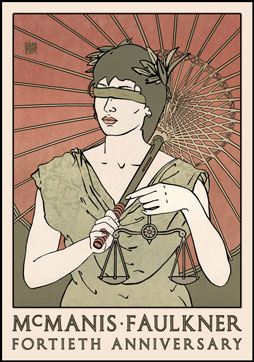
Click on image for detail
(229) McMANIS FAULKNER 40th ANNIVERSARY:
Edition of 1792 of which 125 copies are signed 1-125, 26 copies are signed A-Z as artist's proofs.
Three sets of progressives are signed.
January 21, 2012
17-1/2" x 24"
10 Colors
Paper: Starwhite Vicksburg Sirius 110# Cover
Models: Mina Melinda Reimer
Client: McManis Faulkner
1-125: Saint Hieronymus Press
A-Z: Artist's own use
Progressives: One set to McManis Faulkner, two sets to Saint Hieronymus Press
Dedication copies: James McManis; William Faulkner; Catherine Bechtel; Marwa Elzankaly; Sharon Kirsch; Neda Mansoorian; Elizabeth Pipkin; Michael Reedy; Sara Wigh; Jyl Savard
I am always reluctant to tell people what I had in mind when I came up with a design. In the first place, merely because I made the piece, it does not follow that I know what it means. The Jungian concept of the collective unconscious, wherein we all partake more or less equally of the human experience, is nowhere more valid than in the visual arts. Basically, the artist is dipping into a well that is made up of the whole of our racial history. The selections of images may have some small aspect of intent, but beneath that veneer is a depthless complexity of symbolism to which each viewer brings his own, slightly separate, interpretation. If the artist presumptuously interferes with the individual's interpretation, he is doing the viewer a great disservice. Since he can't see any more than anyone else, despite the incidental fact that he conjured the image up, his opinion is no more valid than another's. However, the viewer may be inclined, because of a misunderstanding of the artist's relationship to his art, to feel that the artist has a special ability to verbalize and interpret, and thus give the artist's point of view greater weight than his own. Not only is this pernicious, subjugating one perfectly sound vision for another which is merely different, but it leaves in the viewer's mind a slight, ineffable feeling of unease and inferiority, which redounds to the loose-lipped artist's discredit. For, if the artist's point of view disagrees with his, it makes him feel like a fool. But, because I am the artist, and he asked my opinion, he feels compelled to give my interpretations greater credit than his own, if not the credibility of Scripture, and this makes him feel even worse. So, everyone leaves feeling a little bit irritated, when in fact the opposite should be the goal. The very worst cases are those where the artist is terrified that his audience will not, without a helping hand, grasp the deep significance of his artwork, and so runs off at the mouth to such an extent that the words, in many cases, replace—or even become—the art. So, in short, I have learned never to pass up a Golden Opportunity to keep my mouth shut. This came as the result of several experiences, the most dramatic of which resulted in a genuinely vicious letter from a young woman who had asked me what I meant by the symbolism in the "Blaue Engel" poster. I cheerfully rattled on and on, and she left, clearly displeased. Later, I received a letter from her which bitterly castigated me for my incorrect interpretation and insulting rejection of her far more perceptive viewpoint. The lesson was not lost on me, and I began to clam up, responding, when asked, "Well, what do you think?" After they talk a while, usually interpreting things in an entirely novel way, I respond to the tune of, "What an interesting interpretation, thank you." They leave well satisfied that they have plumbed the depths of my soul, and I leave without having had to talk very much.
January 21, 2012